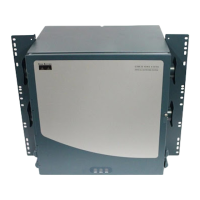5-16
Cisco ONS 15454 Procedure Guide, R5.0
December 2004
Chapter 5 Turn Up Network
NTP-A176 Four-Fiber BLSR Acceptance Test
• For OC-N circuits, complete the “NTP-A257 Create an Automatically Routed OC-N Circuit”
procedure on page 6-38. When you set the circuit state, choose IS and check the Apply to drop
ports check box.
Step 9 Configure the test set for the test circuit type you created:
• DS-1—If you are testing a DS-1 that is not multiplexed, you must have a DSX-1 panel or a direct
DS-1 interface into the ONS 15454. Set the test set for DS-1. For information about configuring
your test set, consult your test set user guide.
• DS-3—If you are testing a clear channel DS-3, you must have a DSX-3 panel or a direct DS-3
interface into the ONS 15454. Set the test set for clear channel DS-3. For information about
configuring your test set, consult your test set user guide.
• DS3XM-6/DS3XM-12—If you are testing a DS-1 circuit on a DS3XM-6 or DS3XM-12 card you
must have a DSX-3 panel or a direct DS-3 interface to the ONS 15454. Set the test set for a
multiplexed DS-3, then choose the DS-1 to test on the multiplexed DS-3. For information about
configuring your test set, consult your test set user guide.
• OC-N—If you are testing an OC-N circuit, set the test set for the applicable circuit size. For
information about configuring your test set, consult your test set user guide.
Step 10 Verify the integrity of all patch cables that will be used in this test by connecting one end of the cable to
the test set Tx connector and the other end of the cable to the test set Rx connector. If the test set does
not run error-free, check the cable for damage and check the test set to make sure it is set up correctly
before continuing.
Step 11 Create a physical loopback at the circuit destination card. To do so, attach one end of a patch cable to
the destination port’s Tx connector; attach the other end to the port’s Rx connector.
Step 12 At the circuit source card:
a. Connect the Tx connector of the test set to the circuit Rx connector.
b. Connect the test set Rx connector to the circuit Tx connector.
Step 13 Verify that the test set shows a clean signal. If a clean signal does not appear, repeat Steps 6 through 12
to make sure the test set and cabling are configured correctly.
Step 14 Inject global BIT errors from the test set. Verify that the errors appear at the test set, verifying a complete
end-to-end circuit.
Step 15 Complete the “DLP-A356 TCC2/TCC2P Card Active/Standby Switch Test” task on page 20-40.
Step 16 Complete the “DLP-A255 Cross-Connect Card Side Switch Test” task on page 19-37.
Step 17 Complete the “DLP-A91 BLSR Switch Test” task on page 17-87 to test the BLSR protection switching
at Node 1.
Step 18 Complete the “DLP-A93 Four-Fiber BLSR Span Switching Test” task on page 17-93 at Node 1.
Step 19 Set up and complete a BER test on the test circuit between Node 1 and 2. Use the existing configuration
and follow your site requirements for length of time. Record the test results and configuration.
Step 20 Complete the “DLP-A333 Delete Circuits” task on page 20-21 for the test circuit.
Step 21 At Node 2, repeat Steps 5 through 20, creating a test circuit between Node 2 and the node connected to
the east OC-N trunk (span) card of Node 2, which is Node 3. Work your way around the BLSR creating
test circuits between every two consecutive nodes.
Step 22 After you test the entire ring, remove any loopbacks and test sets from the nodes.
Step 23 Click the Alarms tab.
a. Verify that the alarm filter is not on. See the “DLP-A227 Disable Alarm Filtering” task on
page 19-17 as necessary.

